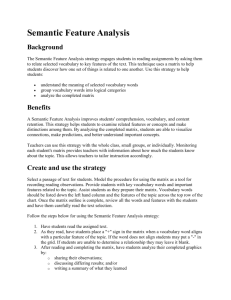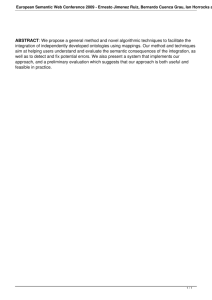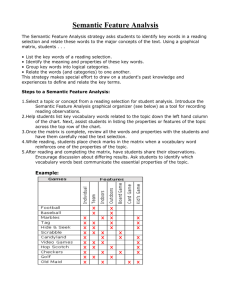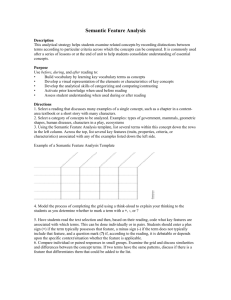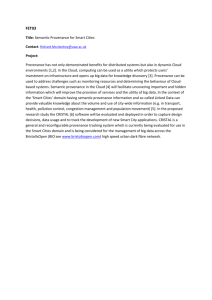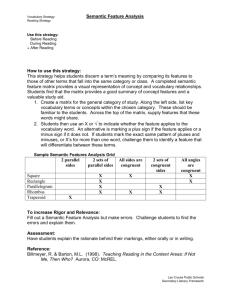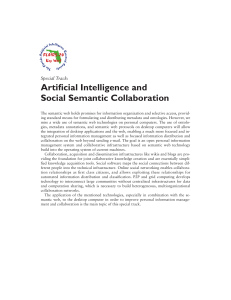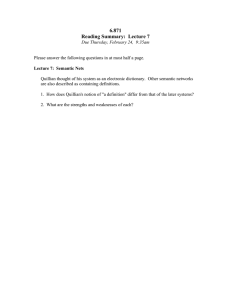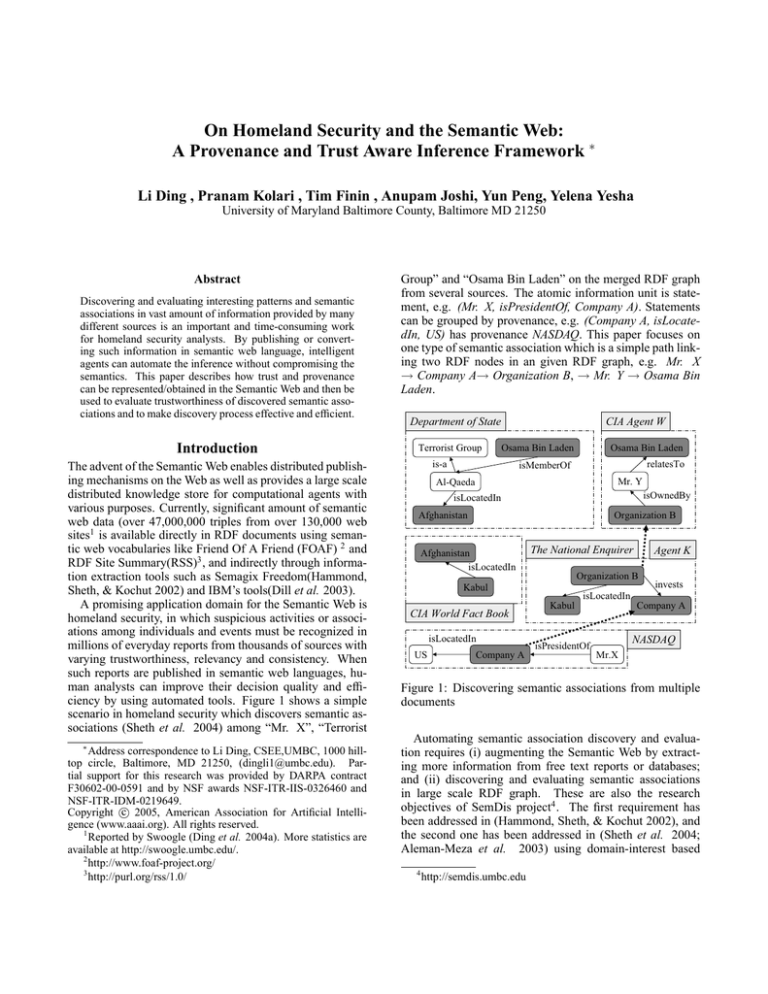
On Homeland Security and the Semantic Web:
A Provenance and Trust Aware Inference Framework ∗
Li Ding , Pranam Kolari , Tim Finin , Anupam Joshi, Yun Peng, Yelena Yesha
University of Maryland Baltimore County, Baltimore MD 21250
Abstract
Discovering and evaluating interesting patterns and semantic
associations in vast amount of information provided by many
different sources is an important and time-consuming work
for homeland security analysts. By publishing or converting such information in semantic web language, intelligent
agents can automate the inference without compromising the
semantics. This paper describes how trust and provenance
can be represented/obtained in the Semantic Web and then be
used to evaluate trustworthiness of discovered semantic associations and to make discovery process effective and efficient.
Introduction
The advent of the Semantic Web enables distributed publishing mechanisms on the Web as well as provides a large scale
distributed knowledge store for computational agents with
various purposes. Currently, significant amount of semantic
web data (over 47,000,000 triples from over 130,000 web
sites1 is available directly in RDF documents using semantic web vocabularies like Friend Of A Friend (FOAF) 2 and
RDF Site Summary(RSS)3 , and indirectly through information extraction tools such as Semagix Freedom(Hammond,
Sheth, & Kochut 2002) and IBM’s tools(Dill et al. 2003).
A promising application domain for the Semantic Web is
homeland security, in which suspicious activities or associations among individuals and events must be recognized in
millions of everyday reports from thousands of sources with
varying trustworthiness, relevancy and consistency. When
such reports are published in semantic web languages, human analysts can improve their decision quality and efficiency by using automated tools. Figure 1 shows a simple
scenario in homeland security which discovers semantic associations (Sheth et al. 2004) among “Mr. X”, “Terrorist
∗
Address correspondence to Li Ding, CSEE,UMBC, 1000 hilltop circle, Baltimore, MD 21250, (dingli1@umbc.edu). Partial support for this research was provided by DARPA contract
F30602-00-0591 and by NSF awards NSF-ITR-IIS-0326460 and
NSF-ITR-IDM-0219649.
c 2005, American Association for Artificial IntelliCopyright °
gence (www.aaai.org). All rights reserved.
1
Reported by Swoogle (Ding et al. 2004a). More statistics are
available at http://swoogle.umbc.edu/.
2
http://www.foaf-project.org/
3
http://purl.org/rss/1.0/
Group” and “Osama Bin Laden” on the merged RDF graph
from several sources. The atomic information unit is statement, e.g. (Mr. X, isPresidentOf, Company A). Statements
can be grouped by provenance, e.g. (Company A, isLocatedIn, US) has provenance NASDAQ. This paper focuses on
one type of semantic association which is a simple path linking two RDF nodes in an given RDF graph, e.g. Mr. X
→ Company A→ Organization B, → Mr. Y → Osama Bin
Laden.
Department of State
Terrorist Group
CIA Agent W
Osama Bin Laden
Osama Bin Laden
is-a
relatesTo
isMemberOf
Mr. Y
Al-Qaeda
isOwnedBy
isLocatedIn
Afghanistan
Organization B
Afghanistan
isLocatedIn
The National Enquirer
Organization B
Kabul
CIA World Fact Book
isLocatedIn
US
Company A
Agent K
invests
isLocatedIn
Kabul
isPresidentOf
Company A
NASDAQ
Mr.X
Figure 1: Discovering semantic associations from multiple
documents
Automating semantic association discovery and evaluation requires (i) augmenting the Semantic Web by extracting more information from free text reports or databases;
and (ii) discovering and evaluating semantic associations
in large scale RDF graph. These are also the research
objectives of SemDis project4 . The first requirement has
been addressed in (Hammond, Sheth, & Kochut 2002), and
the second one has been addressed in (Sheth et al. 2004;
Aleman-Meza et al. 2003) using domain-interest based
4
http://semdis.umbc.edu
methods. This paper proposes an trust and provenance aware
approach to the second requirement.
The Semantic Web has several characteristics which call
for a trust and provenance based scheme: (i) data could be
published throughout the Web by many sources; and (ii) data
could be incomplete or semantically inconsistent. The open
nature and space complexity will ultimately restrict us from
reasoning on the entire knowledge from the Semantic Web;
however, we can effectively prune parts of the graph by disregarding a subset of statements without compromising the
final result. This is possible by leveraging the fact that not
all of the information is required, much of it is irrelevant,
and not all knowledge sources are trustworthy. Even after
pruning, the coexistence of inconsistent statements will continue to inhibit logical inference, but trust and provenance
support well-known heuristics that can resolve inconsistency
through consensus based statements selection.
In the rest of this paper, we describe an inference framework to address the following issues: (i) how to capture
provenance and trust information, (ii) how to use provenance
and trust to evaluate the trustworthiness of a semantic association, and (iii) how to use trust and provenance to prune
search on the Semantic Web.
Provenance and Trust Aware Inference
In order to deal with open and large-scale nature of the Semantic Web, we propose a provenance and trust aware inference framework based on the following assumptions:
• We assume that large amount of semantic web data are
available and contains relevant information. We will not
discuss how semantic web data is available on the Web
through editors and information extraction tools.
• We assume the existence of domain filters that can exclude irrelevant information. Interested readers are encouraged to consult (Ding et al. 2004b; Sheth et al. 2004)
for domain based information filtering. We also assume
that domain filters only reason about relevance and are
not sensitive to the trustworthiness or completeness of the
information they evaluate.
• We assume sufficient information for deriving social and
provenance knowledge, for example, social network, personal profile, social reputation, inter-personal trust and associations between web pages and social entities.
Capturing Provenance and Trust
Based on (Ding & Finin 2003), we argue that both
provenance and trust are essentially associations among
foaf:Agent, rdfs:Statement, and wob:RDFDocument, i.e.
statements are created/used by agents and serialized in RDF
documents. Although this model is not novel, it is needed
but not yet used in the Semantic Web.
We focus on the provenance of statements and RDF documents and several well known provenance relations: (i)
where – a statement can be physically serialized in one
or more RDF documents on the Web, e.g. the statement (Company A, isLocatedIn, US) has sourceDocument
http://example.com/nasdaq.rdf ; (ii) whom – a RDF document or a set of statements may be created/published by
one or more agents, e.g. http://example.com/nasdaq.rdf has
creator NASDAQ; and (iii) why – a set of statements is often copied/derived from several other sources. Provenance
shows how statements are organized among agents on the
Web; therefore, we may partition the semantic web data using where-provenance and whom-provenance. With whyprovenance, users may further track a set of statements’
“history of ownership” or “proof trace”.
Here, we adopt the truthful and consistent semantics for
trust, i.e. a set of statements are trusted by an agent only
when they are consistent and believed to be true. We focus
on two important associations in trust study: belief, which
shows an agent’s trust in a set of statements, and trust which
shows an agent’s trust in another agent’s knowledge. The
two associations shares many facets such as ‘trustor’, ‘trust
assertion’, ‘confidence’ and only differs in the trusted object
and the range of ‘confidence’ 5 .
Belief can be derived from whom-provenance, e.g., NASDAQ fully believes (Company A, isLocatedIn, US) because
it is the creator of http://example.com/nasdaq.rdf which contains the statement.
Inter-personal trust can often be derived in two steps.
First, some common-sense rules are employed to extract social relations from raw semantic web data. For example, {
(X is author of P), (Y is author of P), (X is not Y) } implies
coauthor relation between X and Y . A more complicated
social relation is “neighborOf(X,Y)” which we might deduce from { (X livesIn C),(Y livesIn C), (C rdf:type Street),(X
is not Y). Second, users may apply personalized rules to infer
trust (including confidence value) from the extracted or existing social networks. Moreover, we may use well-known
online reputation and ranking systems, such as Google and
Citeseer, to derive the default trust in unfamiliar agents.
Trust based Belief Evaluation
Given a set of statements extracted from the Semantic Web,
how much should we trust the model they describe? This
can be viewed as a problem central to document analysis in
which not all information sources are trusted at the same
degree and it has obviously important applications in the
homeland security domain. How much should we trust the
semantic association from “Mr. X” to “Osama Bin Laden”
given that “CIA World Fact Book” is highly trusted but “The
National Enquirer” is somewhat less trusted. A more complex situation occurs when “Agent K” and “The National
Enquirer” have conflicting beliefs over the statement (Organization B, invests, Company A) .
We use the following notations: S = {s1 , s2 , ..sn } be a
set of n statements, x, y, z be distinctive agents, s be any
statement, tv(x, y) be x’s confidence over trustworthiness
of y’s knowledge, H(x) be the set of highly trusted agents
by x, bel(x, S) be x’s confidence on trustworthiness of S
, creator(s) be the set of creator of s, B(s) be the set of
agents who has belief over s.
5
Trust confidence ranges in [0,1] where 0 for fully distrust, 0.5
for ignorance and 1 for fully trust(Ding et al. 2004b). Belief confidence ranges from [-1,1] where -1 for fully disbelief, 0 for nonbelief, and 1 for fully belief.
We first examine a simple situation satisfying the following assumptions: (i) statements are independent, semantically consistent, and fully believed by their creators, and
(ii) the creators are independent and the investigator z has
correct turst knowledge over the them. Equation 1 shows a
Bayes model for computing z’s overall confidence over S.
With the first assumption, we can compute z’s confidence
over each member of S and then multiply them. With the
second assumption, we compute z’s confidence over a statement using “Noise-Or” Bayes model (Peng & Reggia 1990).
Y
Y
1 −
bel(z, S) =
(1 − tv(z, x)) (1)
si ∈S
x∈creator(si )
For example, given tv(z,NASDAQ)=0.99, tv(z,The National Enquirer=0.5, tv(Z, Agent K)=0.6, tv(z, Agent
W)=0.8), z’s confidence on S0, i.e. the semantic path from
“Mr.X” to “Osama Bin Laden”, is bel(z, S0) = 0.99 × (1 −
(1 − 0.5)(1 − 0.6)) × 0.8 ∼
= 0.63. This path is much more
trustworthy than the cases that only one of “Agent K” and
“The National Enquirer” is the creator.
However, statements sometimes could be semantically inconsistent and agents (even the creators) could assert beliefs
with various confidence over statements, e.g. two sources
believe in different names for the same person with different
confidence. A straightforward approach is consensus model
which is based on the intuition that trusted peers’ beliefs are
the only sources of reliable information. Equation 2 averages the discounted belief confidence from trusted agents.
Y
X
tv(z, x) ∗ bel(x, {si })
bel(z, S) =
|B(si ) ∩ H(z)|
si ∈S
x∈B(si )∩H(z)
(2)
Let s1 be the statement “Organization B invests Company
A”. Suppose two agents, i.e. ne(The National Enquirer) and
ak(Agent K), have conflicting beliefs, i.e. bel(ne, {s1})=1 and bel(ak, {s1})=1. The analyst z’s final belief confidence depends on her trusts in the two agents: (i) when
tv(z,ne)=0.5 and tv(z,ak)=0.9, bel(z, {s1}) = (−0.5 +
0.9)/2 = 0.2 and (ii) when tv(z,ne)=0.5 and tv(z,ak)=0.5,
bel(z, {s1}) = (−0.5 + 0.5)/2 = 0 In both cases, z has two
small confidence on that s1 and needs more field investigation reports. The absolute value of bel(z, s1) also shows that
the second case should be investigated first.
Trust based Knowledge Expansion
The size of the knowledge base determines the space
complexity of inference over it. There are two well-known
heuristics that controls knowledge base size: domain interest heuristic, which prioritizes knowledge based on domain
of interest, and trust and provenance based heuristic, which
prioritizes knowledge sources by trust. The primary difference is that the former requires services that categorizes
and indexes all knowledge while the latter uses P2P trust
network to navigate the Semantic Web and incrementally
incorporates trusted external knowledge sources. With trust
and provenance, an agent A runs semantic web inference
(SWInference) as breath first search as shown below. The
input includes: the agent A who conduct the inference, the
query of the inference, A’s trust network T NA , a trust
threshold α and a social distance threshold β.
SWInference( A, query, T NA , α, β):
1. distance=0, KB={}, Agents ={}
2. if (distance > β) return;
3. newAgents = findAgents(T NA , A, Agents, α, distance)
4. if (newAgents is empty) then return fail
5. Agents = Agents ∪ newAgents
6. KB = mergeKnowledge(T NA , A, newAgents, KB)
7. doInference( KB, query)
8. if (query is answered) then return with result
9. else distance++ and go to step 2
findAgents finds trusted agents from A’s trust network
with specified social distance from A. mergeKnowledge derives A’s combined trust to all trusted agents according to
the trust network, and merges the agents’ knowledge using
mechanisms described in section . We leave the details of
these two functions to our previous work (Ding, Zhou, &
Finin 2003; Ding et al. 2004b). doInference essentially runs
a conventional inference. Semantic web inference terminates when (i) an answer is found at step 8, (ii) no more
trust agents can be found at step 4, or (iii) the social distance
limit is reached at step 2. Therefore, the space complexity,
which is the union of trusted agents’ knowledge within certain social distance, is bounded by α and β. In addition,
“doInference” runs at most β times.
Another good feature of SWInference is that it assures
completeness of high quality data (confidence above α and
social distance below β)6 . With such heuristics, semantic association discovery, which can be abstracted as finding subgraphs in RDF graph, will first use knowledge from the most
trusted information sources like “Agent K” and then expand
to less reliable sources like “The National Enquirer”.
The performance of SWInference depends on the correctness of A’s trust network. Existing works have shown effective mechanisms in evolving local trust by evaluating results
using relevance utility function (Yu, Venkatraman, & Singh
2003) or using consensus based truthfulness utility function
(Ding, Zhou, & Finin 2003). Moreover, by adding domaininterest facet in trust relation, the trust network may be constructed with respect to the domain interests and results in
more efficient, for example, an analyst would not ask NASDAQ whether Al-Qaeda is a terrorist group despite of NASDAQ is highly trusted in stock domain.
Related Work
Provenance has been studied in digital library (e.g. Dublin
Core7 ), database systems, (e.g. data provenance (Buneman,
Khanna, & Tan 2001) and view maintains (Cui, Widom,
& Wiener 2000)) and artificial intelligence (e.g. knowledge provenance (da Silva, McGuinness, & McCool 2003;
6
Social distance and trust are both important quality factors.
Social distance is a good heuristic to control risk, e.g., I may not believe any statement from my best friend’s best friend’s best friend.
7
http://dublincore.org/
Fox & Huang 2003) and proof tracing (da Silva, McGuinness, & Fikes 2004)). Our work focuses on provenance in
the Semantic Web context, and how it combines with trust
network. Provenance network in the semantic web offers
multiple-granularity way to group statements.
Trust based belief evaluation has been addressed from information assurance perspective(Hyvonen 2002). Recently,
(Golbeck, Parsia, & Hendler 2003; Richardson, Agrawal, &
Domingos 2003; R.Guha et al. 2004; Ding et al. 2004b)
have remarked trust network as an social alternative. Our
work focuses on utilizing trust and provenance in evaluating
statements obtained from multiple sources.
The use of trust in reducing search complexity has been
mentioned in (Marsh 1994) and realized in (Yu & Singh
2003; Ding, Zhou, & Finin 2003). Our approach focuses
on how to create a trust network statically(offline) from the
Semantic Web through rule based inference, and how to utilize trust and provenance to prune search space.
Conclusions and Future Work
We have described a provenance and trust aware inference
framework including (i) an ontology for representing associations of trust and provenance; (ii) mechanisms to evaluate the trustworthiness of semantic association or any collection of statements obtained from multiple sources, and (iii) a
trust based knowledge expansion mechanism that incrementally outsources knowledge from peers to bound the size of
knowledge base for inference.
Representing belief is a complex issue since it requires
explicit reference of RDF graph. Existing approaches are
simply referring the entire RDF graph in an RDF document,
RDF reification (Hayes 2004), and Named Graphs (Carroll
et al. 2004). However, none of them is both efficient and
expressive to reference an arbitrary RDF graph. Future work
will build an RDF graph reference language.
The two trust based belief evaluation methods in this paper treat a statement as an atom. Future work will study the
ontological dependency among statements.
Even with trust based knowledge expansion, serious scalability issues for local inference remain. Future work will
find effective tools that support large scale local inference.
References
Aleman-Meza, B.; Halaschek, C.; Arpinar, I. B.; and Sheth, A.
2003. Context-aware semantic association ranking. In First International Workshop on Semantic Web and Databases.
Buneman, P.; Khanna, S.; and Tan, W.-C. 2001. Why and where:
A characterization of data provenance. In International Conference o Database Theory (ICDT), 316–330.
Carroll, J. J.; Bizer, C.; Hayes, P.; and Stickler, P. 2004. Named
graphs, provenance and trust. Technical Report HPL-2004-57,
HP Lab.
Cui, Y.; Widom, J.; and Wiener, J. L. 2000. Tracing the lineage of view data in a warehousing environment. ACM Trans. on
Database Systems 25(2):179–227.
da Silva, P. P.; McGuinness, D. L.; and Fikes, R. 2004. A proof
markup language for semantic web services. Technical Report
KSL-04-01, Stanford.
da Silva, P. P.; McGuinness, D. L.; and McCool, R. 2003.
Knowledge provenance infrastructure. Data Engineering Bulletin
26(4):26–32.
Dill, S.; Eiron, N.; Gibson, D.; Gruhl, D.; Guha, R.; Jhingran,
A.; Kanungo, T.; Rajagopalan, S.; Tomkins, A.; Tomlin, J. A.;
; and Zien, J. Y. 2003. Semtag and seeker: Bootstrapping the
semantic web via automated semantic annotation. In The Twelfth
International World Wide Web Conference (WWW2003).
Ding, L., and Finin, T. 2003. Weaving the web of belief into the
semantic web.
Ding, L.; Finin, T.; Joshi, A.; Pan, R.; Cost, R. S.; Peng, Y.; Reddivari, P.; Doshi, V. C.; ; and Sachs, J. 2004a. Swoogle: A search
and metadata engine for the semantic web. In Proceedings of
the Thirteenth ACM Conference on Information and Knowledge
Management.
Ding, L.; Kolari, P.; Ganjugunte, S.; Finin, T.; ; and Joshi, A.
2004b. Modeling and evaluating trust network inference. In Seventh International Workshop on Trust in Agent Societies at AAMAS 2004.
Ding, L.; Zhou, L.; and Finin, T. 2003. Trust based knowledge outsourcing for semantic web agents. In Proceedings of
IEEE/WIC International Conference on Web Intelligence.
Fox, M., and Huang, J. 2003. Knowledge provenance: An approach to modeling and maintaining the evolution and validity of
knowledge. Technical report, University of Toronto.
Golbeck, J.; Parsia, B.; and Hendler, J. 2003. Trust networks
on the semantic web. In Proceedings of Cooperative Intelligent
Agents.
Hammond, B.; Sheth, A.; and Kochut, K. 2002. Semantic enhancement engine: A modular document enhancement platform
for semantic applications over heterogeneous content. In Real
World Semantic Web Applications. IOS Press. 29–49.
Hayes, P. 2004. Rdf semantics (w3c recommendation, 10 february 2004). http://www.w3.org/TR/2004/REC-rdf-mt-20040210/.
Hyvonen, E. 2002. The semantic web – the new internet of
meanings. In Semantic Web Kick-Off in Finland: Vision, Technologies,Research, and Applications.
Marsh, S. P. 1994. Formalising trust as a computational Concept.
Ph.D. Dissertation, University of Stirling.
Peng, Y., and Reggia, J. 1990. Abductive Inference Models for
Diagnostic Problem Solving. Springer-Verlag.
R.Guha; Kumar, R.; Raghavan, P.; and Tomkins, A. 2004. Propagation of trust and distrust. In Proceedings of the 1st Workshop
on Friend of a Friend, Social Networking and the Semantic Web.
Richardson, M.; Agrawal, R.; and Domingos, P. 2003. Trust
management for the semantic web. In Proceedings of the Second
International Semantic Web Conference.
Sheth, A.; Aleman-Meza, B.; Arpinar, I. B.; Halaschek, C.; Ramakrishnan, C.; Bertram, C.; Warke, Y.; Avant, D.; Arpinar, F. S.;
Anyanwu, K.; and Kochut, K. 2004. Semantic association identification and knowledge discovery for national security applications. Special Issue of Journal of Database Management on
Database Technology for Enhancing National Security.
Yu, B., and Singh, M. P. 2003. Searching social networks. In
Proceedings of the 2nd International Joint Conference on Autonomous Agents and MultiAgent Systems (AAMAS).
Yu, B.; Venkatraman, M.; and Singh, M. P. 2003. An adaptive social network for information access: Theoretical and experimental results. Journal of the Applied Artificial Intelligence 17(1).

